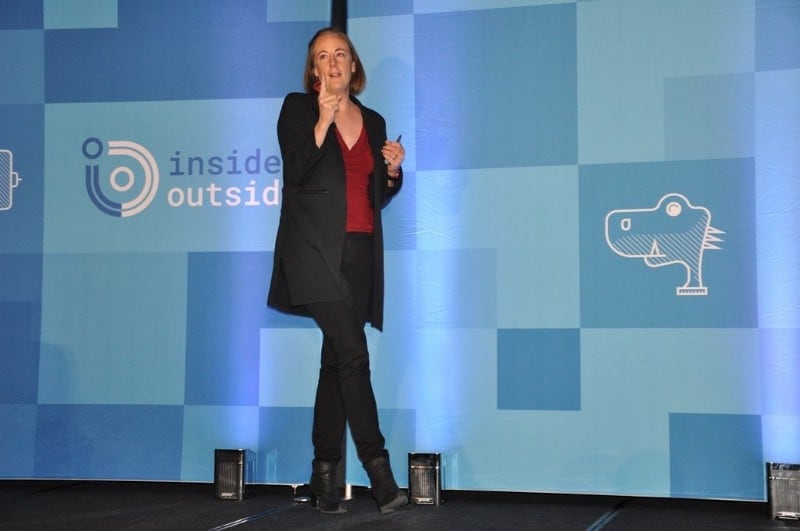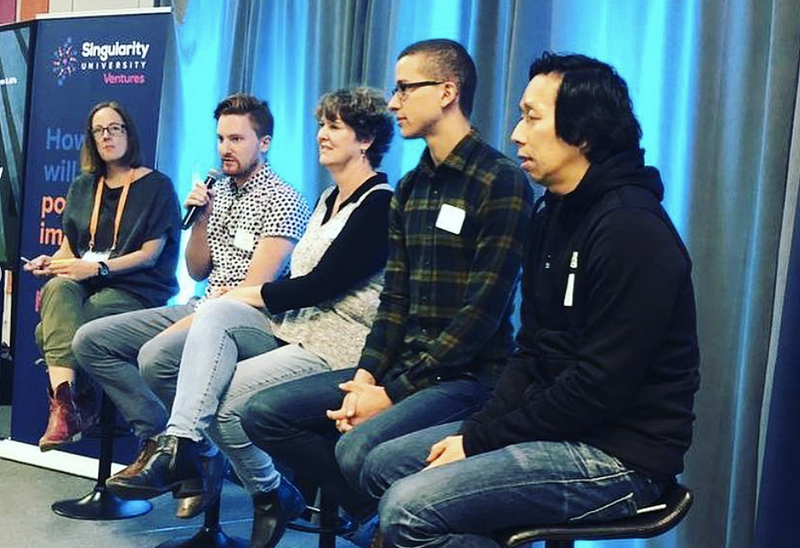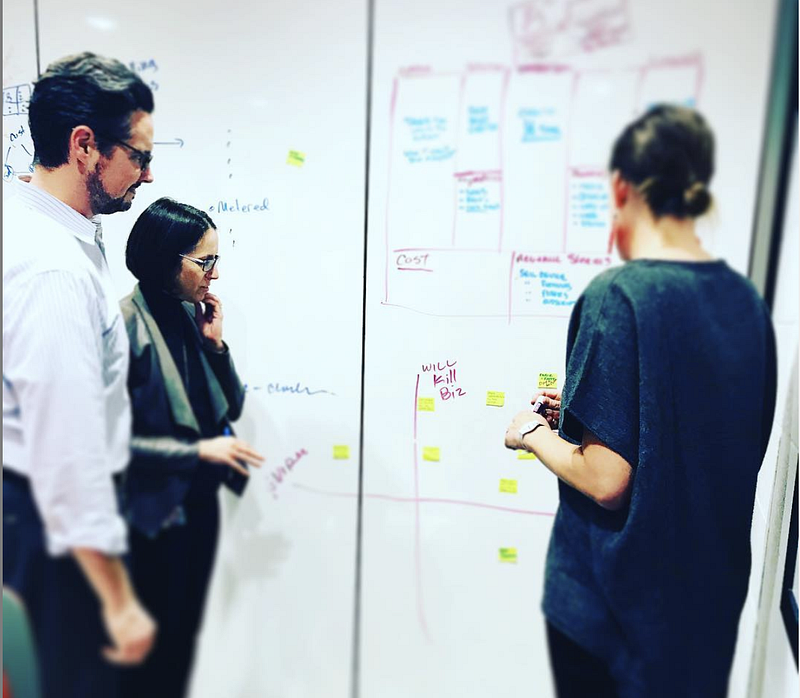A conversation with innovation consultant, Andi Plantenberg
Andi Plantenberg is an innovation consultant who brings entrepreneurial practices into the enterprise. She’s a long-time mentor for startups in the Bay Area, focused on giving them tools to know if their product and business strategies are working. Prior, Andi co-founded Singlebound Creative in 2000. The Product Studio / Digital Agency had an eleven-year run and served Fortune 500 clients and visionary startups.
In addition to consulting large companies, Andi is also a faculty member at Lean Startup Co, and mentors at 500 startups and Singularity University. Something you might not know about Andi is that she’s the founder of Qoopy.co, a luxury daycare for chickens, the fake business that went viral a few years back.

Innovation for Enterprises
Andi spends most of her days working with big companies to help them adopt principles of innovation from the startup world. These Fortune 500 companies get so big, they forget how to scale to the next level, or test new product ideas with a small group, and most spend millions more than they need to get data they don’t need.
Even in the startup world, Andi believes, the traditional approach to innovation is somewhat flawed. Within the accelerator and incubator programs, there’s a general approach to do some customer discovery upfront, then build something to show at their pitch day, and then hopefully participants will get funding.
“The world is full of really important problems to solve, but there’s not always an obvious market for them.”
The problem with this, Andi says, is “You can have problem-solution fit without a product-market fit. The world is full of really important problems to solve, but there’s not always a viable market for them or an obvious market for them. The two are different.” Taking time to consider if the problem has a viable product before you build it might save a lot of time and money.


This incubator model also assumes that you do all the learning you’ll need to in the beginning and then scale and keep scaling. Andi believes, “In the early years, there’s just so much learning to be had that it’s a mistake not to have an emphasis on being optimized for learning from the get-go. You see that mirrored in corporate innovation as well.”
Andi sees how the mistakes that start at the very beginning of a company are easily carried over and have a significant impact on how that company will scale and ultimately run and innovate.
“For the past 100 years or so, we have been running our businesses as if we can do a bunch of research, make plans, fund those plans, do things, and have those things work. That’s the way the world was before this huge technological shift of the past two decades turned everything upside down. We have institutions that are built around that reality which no longer exists, and we’re all slowly waking up to the new reality.”
In her years of working through these problems with different startups and enterprises, she’s broken down what innovation is and the processes behind it — they have tremendous value for all of us (regardless of the stage our business is in.)
A Better Definition for Innovation
I found Andi’s definition of innovation refreshing. She adds more meaning than we’ve heard before, “Innovation is not just a new way to add value, but it’s done in a manner that can be sustained,” she says. Adding on that sustained piece is a big differentiator.

This kind of innovation, Andi says, starts with “getting committed to learning fast.” Companies are choosing a few ideas and spending too much time researching and pouring money into these ideas with no assurance they’ll work. Andi asks, “What happens when your two best ideas that you’ve been lovingly caressing for the past three years are failed experiments?”
When I asked Andi how she goes about changing this in large companies, she said, “An ‘innovation thesis’ is an important thing to have. Which ideas are the right ideas to put through the paces? Of those ideas, we might get a hit. The innovation thesis is similar to what venture capitalists would call an investment thesis, but it’s about where we’re innovating and why.” (Note: Andi credits the concept of the ‘innovation thesis’ to Dan Toma, author of The Corporate Startup.)
She mentioned that it’s something that changes over time, a living document, like FutureTight’s Business Model Canvas Workshop. From this sort of document, “we look at emerging trends in society, in technology, in the political arenas and in things that are megatrends that are likely to impact the business model but are not directly involved in the business model.”
All of this information is great, but what do we do with it? How does it impact where we go? Andi has an insightful take on the numbers.

Measuring Innovation ROI
Measuring something as abstract as innovation can seem impossible, but that, Andi says, is because companies are measuring the wrong things. Andi reminded us that, “ROI is meant to measure known solutions rolling out into a known market.” And because that is the purpose of ROI, it has no place this early in the funnel. It can undoubtedly inform our innovation thesis and help us consider what’s vital for our success, but instead of measuring ROI directly, you have to measure the leading indicators. She calls these learning goals.
“I’m a huge fan of measurement, of innovation accounting, and spreadsheets, but you can’t measure success.”
“I’m a huge fan of measurement, of innovation accounting, and spreadsheets, but you can’t measure success.” The customer behavior that you do measure can show you the small hints at the likelihood that something will be successful. So while you can’t measure success exactly, Andi teaches companies how to measure the likelihood of success through specific data.
“A lot of what I do is get out the leaf blower, and I blow away all the data that is not the most important data for today.”
While Andi loves measurement and data, she believes that we simultaneously must be cautious about the data we let shape our decisions. “People get lost in the complexity of data, and people dither around in analysis paralysis. A lot of what I do is get out the leaf blower, and I blow away all the data that is not the most important data for today.” With all of this in mind, I asked Andi to take us through the process she uses for companies like NASA and Bissell.
It Starts With Permission
Let’s say we’re in a Western mining town and we’re building railroads. To build these railroads, we’re going to have to go through the mountains and come close to some of the buildings in the town. Now, one option to say to the people in the town is, “Alright, we’re going to go through this mountain, lay down our tracks, the train design is going to look like this, and we’re just going to send it through. Get ready.” But this way of working might not get the best results if your goal is to have a good relationship with the community.
Another option is to negotiate with the communities on the rail line and bring them in as part of the process. In having these conversations with them, they have the option to get them excited that the train’s going through their area and understand just how the train is going to work for them.
This same process is how innovation works. Andi explains, “Start with permission from the highest levels. You start with one team and use that team as a tracer bullet through the organization. That team is going to get stuck like crazy, and you’re going to look at each of those points up close and sand them down.”

Andi describes that as the first step, and once you do that, these ideas will start to gain momentum and after proven results, the exception to the rule will catch on as a new way of working. The problem is that most companies and even innovation houses force this process too quickly. “They scale their solution for the companies they’re trying to serve to quickly, and they don’t have the opportunity to see how it needs to work before they scale.”
The Lean Startup was built out of this idea of starting small. The notion of measuring based on real customer behavior, customer actions, what’s working and what’s not working, do that at a small scale so that you can roll that back into your plans. And it works so well that we’re not calling it lean startup anymore. We’re just calling it best practice.
Iterating on Innovation
Figuring out these processes isn’t a one and done sort of thing. Andi’s learned this from digging in elbows deep in different teams in startups, in organizations, and the government sector for the past ten plus years, and being an entrepreneur herself and running a digital design agency for ten years before that. The way she has approached innovation has changed and evolved as she’s iterated.
“Entrepreneurship is not about drafting the perfect plan. Entrepreneurship is about figuring it out live.”
It’s like professional athletes and musicians. They are professionals, but they continue to practice their craft, refine their skills, and get better. Andi believes the same goes for businesses and entrepreneurs. “It’s not practicing your trade as a researcher or data analyst — it’s refining your practice around entrepreneurship. Entrepreneurship is not about drafting the perfect plan. Entrepreneurship is about figuring it out live.”

She argues a solid point that: “There’s no world that I’ve seen where someone highly skilled in their trade, whatever it might be, can be put together with other people and just have a business unit stand up out of that.”
No matter who you are and what you’re doing, everything is done through iteration, even innovation.
Gaining an Appetite to Unlearn
Andi teaches big organizations how to make considerable changes to the way they’re operating. She explained that they start small and build up momentum to get everyone on board. While teaching them these processes, she saw that there were many practices these same organizations needed to unlearn to grow. (For more on this concept, I recommend checking out Barry O’Reilly’s book Unlearn: Let Go of Past Success to Achieve Extraordinary Results.)
She gives examples like, for the $800 million a year private company that had two or three ideas they loved and researched for three years, this company needs to unlearn this and test sooner. “Don’t be afraid to kill an idea,” Andi encourages.
“You need to be willing to unlearn what you think the right thing to do is. You have to be willing to learn that a lot of your research might not hold up to customer behavior.”
“When you start doing the work, we might shoot two of those down in a week. You need to be willing to unlearn what you think the right thing to do is. You have to be willing to learn that a lot of your research might not hold up to customer behavior. You have to unlearn some things that you’re thinking that you don’t even realize you’re thinking.”
Innovation in the World
In most startup organizations and tech hubs like the Bay Area, Andi says most people know that the Lean Startup Method is just a best practice, you don’t even speak to it. She believes that the next wave where these ideas and tools can cause a significant shift in the world at large. “If we retool our systems, organizations, and our processes to be able to learn and adapt, they can have a huge impact. There’s a huge appetite for it, and there’s a huge need. It’s creative destruction. It’s happening.”
Andi is excited by the accelerating pace of change and what it means for the world we live in. “It creates a tremendous opportunity (and responsibility) to be purposeful about the world we want to have in 10, 20, and 30 years.”




